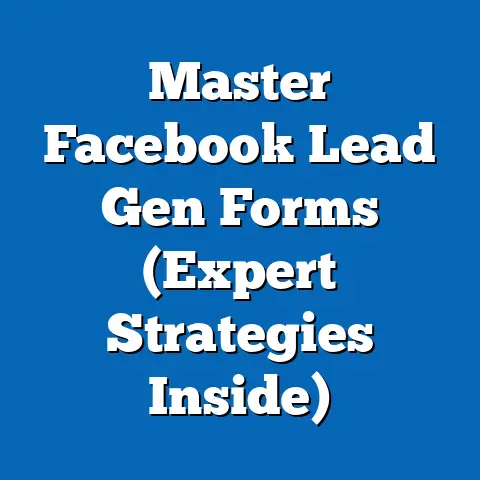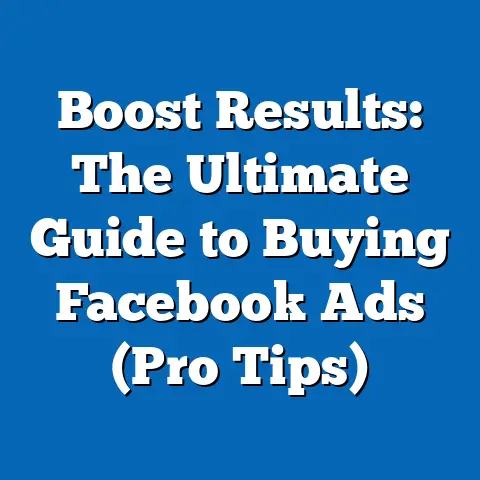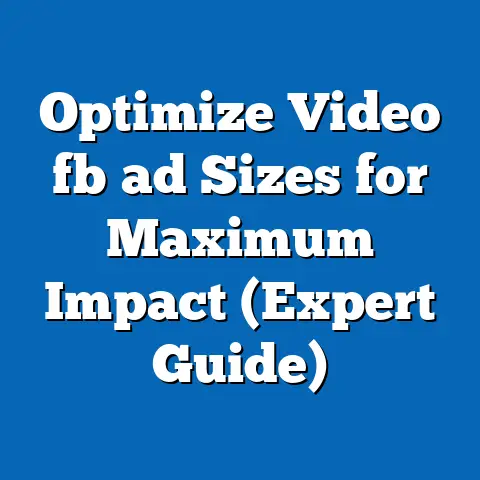Maximize Reach with Facebook Ad Tracker (Expert Insights)
Imagine a battlefield, but instead of soldiers, we have brands. Instead of swords, we wield ad campaigns. The prize? The fleeting attention of billions of users scrolling through their Facebook feeds. In this digital arena, every impression is a skirmish, every click a victory. But without the right intelligence, you’re sending your ads into the abyss, wasting precious resources and losing ground to competitors. This is where the Facebook Ad Tracker steps in, not as a mere tool, but as your strategic command center, the key to unlocking unparalleled reach and engagement. It’s no longer a question of “if” you need it, but “how” you can master it to dominate the advertising landscape.
I’ve seen firsthand how the Ad Tracker can transform campaigns from floundering experiments to roaring successes. One of my clients, a local bakery struggling to compete with larger chains, was on the verge of pulling the plug on their Facebook ads. Their ads were beautifully designed, their offers enticing, but they were simply not reaching the right people. After diving into the Ad Tracker data, we discovered that their target audience was primarily active on Facebook groups related to baking and local food, not on the broad interest categories they were initially targeting. By refining their audience based on these insights, their reach exploded, and their sales followed suit. This isn’t just a story; it’s a testament to the power of data-driven advertising, and the Facebook Ad Tracker is your gateway to that power.
The Power of Facebook Ads
Facebook isn’t just a social media platform; it’s a digital continent. With over 2.9 billion monthly active users as of early 2024, the potential audience is staggering. This sheer scale is what makes Facebook advertising so attractive. It offers businesses the opportunity to connect with a diverse range of potential customers, spanning demographics, interests, and behaviors.
But scale alone doesn’t guarantee success. It’s not enough to simply throw ads into the void and hope they stick. That’s where the strategic power of Facebook ads comes into play. According to recent studies, Facebook ads can drive a 9.21% conversion rate on average, significantly higher than many other digital advertising channels. This statistic highlights the platform’s ability to not only reach a vast audience but also to influence their behavior.
Reach, in the context of advertising, refers to the total number of unique individuals who see your ad. It’s the foundation upon which all other advertising metrics are built. Without adequate reach, your message will simply not be heard, regardless of how compelling it may be. Reach is crucial for business growth because it expands brand awareness, generates leads, and ultimately drives sales. The more people who are exposed to your brand, the greater the opportunity to convert them into loyal customers.
The Facebook Ad Tracker is not just a tool; it’s your guide to navigating this vast digital landscape, ensuring that your message reaches the right people at the right time. In the following sections, I’ll delve into how this tool works and how you can leverage its power to maximize your advertising reach.
Key Takeaway: Facebook’s massive user base and the high conversion rates of its ads make it a powerful platform for businesses. Maximizing reach is crucial for leveraging this potential, and the Facebook Ad Tracker is essential for achieving that goal.
Understanding the Facebook Ad Tracker
The Facebook Ad Tracker, more formally known as Facebook Ads Manager, is a comprehensive platform that allows advertisers to create, manage, and analyze their Facebook and Instagram ad campaigns. It’s the control panel for your advertising efforts, providing a wealth of data and insights to optimize your performance.
At its core, the Ad Tracker provides real-time metrics on your ad campaigns. These metrics can be broadly categorized as:
- Impressions: The number of times your ad was displayed to users. This gives you a sense of how often your ad is being seen.
- Reach: As mentioned earlier, this is the number of unique individuals who saw your ad.
- Clicks: The number of times users clicked on your ad. This indicates the level of interest your ad is generating.
- Click-Through Rate (CTR): The percentage of impressions that resulted in a click. A high CTR suggests that your ad is relevant and engaging to your target audience.
- Conversions: The number of desired actions taken by users after seeing your ad, such as making a purchase, signing up for a newsletter, or downloading a resource.
- Cost Per Acquisition (CPA): The cost of acquiring one conversion. This is a critical metric for measuring the efficiency of your ad spend.
- Audience Demographics: The age, gender, location, interests, and behaviors of the users who are seeing and interacting with your ads.
These metrics, when analyzed effectively, can provide actionable insights that can dramatically improve your advertising reach and performance.
For example, let’s consider a hypothetical case study: “EcoThreads,” a sustainable clothing brand. EcoThreads launched a Facebook ad campaign targeting environmentally conscious consumers. Initially, their ads were reaching a broad audience with limited success. By analyzing the Ad Tracker data, they discovered that their ads were performing particularly well among users who were members of specific environmental advocacy groups and those who had expressed interest in sustainable living.
Based on these insights, EcoThreads refined their targeting to focus on these specific audience segments. They also adjusted their ad copy to highlight the brand’s commitment to sustainability and ethical sourcing. As a result, their reach among their target audience increased significantly, leading to a substantial boost in conversions and a reduction in their CPA.
Key Takeaway: The Facebook Ad Tracker is a powerful tool that provides essential metrics for analyzing and optimizing Facebook ad campaigns. Understanding and leveraging these metrics is crucial for maximizing advertising reach and achieving business goals.
Expert Insights on Maximizing Reach
To truly unlock the potential of the Facebook Ad Tracker, it’s essential to learn from the experts. I’ve had the privilege of working alongside some of the brightest minds in the digital marketing industry, and their insights have been invaluable in helping me and my clients achieve remarkable results.
One common theme that emerges from these experts is the importance of data analysis. It’s not enough to simply collect data; you must be able to interpret it and translate it into actionable strategies.
“The Facebook Ad Tracker is like a treasure map,” says Sarah Miller, a leading digital marketing consultant. “It provides clues to where your ideal customers are hiding and what messages will resonate with them. But you need to know how to read the map.”
Sarah emphasizes the importance of focusing on the right metrics. “Don’t get bogged down in vanity metrics like impressions or likes. Focus on the metrics that directly impact your business goals, such as conversions, CPA, and return on ad spend (ROAS).”
Another key strategy is A/B testing. The Facebook Ad Tracker allows you to easily test different versions of your ads, targeting options, and bidding strategies to identify what works best.
“A/B testing is the lifeblood of any successful Facebook ad campaign,” says David Chen, a Facebook advertising specialist. “It allows you to continually refine your approach and optimize your performance.”
David recommends testing one variable at a time to isolate the impact of each change. “For example, you could test two different headlines, two different images, or two different targeting options. By testing one variable at a time, you can determine which element is driving the best results.”
Audience segmentation is another powerful tactic that can be enhanced by the Facebook Ad Tracker. By dividing your audience into smaller, more targeted segments, you can tailor your ads to their specific needs and interests.
“The more specific your targeting, the more relevant your ads will be,” says Emily Rodriguez, a social media marketing expert. “This will lead to higher engagement rates, lower costs, and ultimately, greater reach among your ideal customers.”
Emily suggests using the Facebook Ad Tracker to identify the most effective audience segments. “Look for patterns in the data. Which audience segments are converting at the highest rate? Which segments have the lowest CPA? Use these insights to refine your targeting and focus your efforts on the most promising segments.”
Finally, optimizing your ad creatives and copy based on performance data is crucial for maximizing reach. The Facebook Ad Tracker provides valuable feedback on which ads are resonating with your audience and which ones are falling flat.
“Pay attention to the click-through rate (CTR) and the conversion rate of your ads,” says Michael Lee, a content marketing strategist. “A low CTR suggests that your ad is not engaging enough, while a low conversion rate suggests that your landing page or offer is not compelling enough.”
Michael recommends continually testing different ad creatives and copy to find the winning combination. “Use the Facebook Ad Tracker to track your performance and make data-driven decisions. Don’t be afraid to experiment and try new things. The key is to keep learning and iterating until you find what works best for your audience.”
Key Takeaway: Expert insights highlight the importance of data analysis, A/B testing, audience segmentation, and creative optimization in maximizing reach with the Facebook Ad Tracker. By implementing these strategies, advertisers can significantly improve their campaign performance and achieve their business goals.
Common Pitfalls and How to Avoid Them
While the Facebook Ad Tracker is a powerful tool, it’s also easy to make mistakes that can lead to wasted ad spend and suboptimal results. I’ve seen many advertisers fall into these common pitfalls, and I want to share some insights on how to avoid them.
One common mistake is misinterpreting the data. The Facebook Ad Tracker provides a wealth of information, but it’s important to understand what the data is telling you.
“Don’t jump to conclusions based on limited data,” warns Lisa Johnson, a data analytics consultant. “Make sure you have enough data to draw meaningful insights. Look for trends and patterns over time, rather than focusing on short-term fluctuations.”
Another pitfall is focusing on vanity metrics rather than business metrics. As mentioned earlier, it’s important to focus on the metrics that directly impact your business goals, such as conversions, CPA, and ROAS.
“Don’t get distracted by metrics like impressions or likes,” says John Smith, a marketing director. “These metrics can be misleading. Focus on the metrics that demonstrate a clear return on investment.”
Ignoring the importance of continual monitoring and adjustment is another common mistake. The Facebook advertising landscape is constantly evolving, and what works today may not work tomorrow.
“Don’t set it and forget it,” says Maria Garcia, a social media manager. “You need to continually monitor your campaigns and make adjustments based on real-time data. Be prepared to adapt your strategy as needed.”
Over-targeting or under-targeting your audience can also be detrimental. Over-targeting can lead to limited reach and high costs, while under-targeting can lead to irrelevant ads and low engagement rates.
“Finding the right balance is key,” says Robert Davis, a targeting specialist. “Experiment with different targeting options and use the Facebook Ad Tracker to identify the most effective segments.”
Finally, neglecting to optimize your ad creatives and copy is a common mistake that can significantly impact your results. As mentioned earlier, it’s important to continually test different ad creatives and copy to find the winning combination.
“Your ads are your first impression,” says Susan Brown, a creative director. “Make sure they are visually appealing, engaging, and relevant to your target audience. Use the Facebook Ad Tracker to track your performance and make data-driven decisions.”
Key Takeaway: Avoiding common pitfalls such as misinterpreting data, focusing on vanity metrics, neglecting to monitor and adjust campaigns, over-targeting or under-targeting, and neglecting to optimize ad creatives and copy is crucial for maximizing the effectiveness of the Facebook Ad Tracker and achieving advertising success.
Conclusion
In the fast-paced world of Facebook advertising, the Facebook Ad Tracker is your compass and your map. It’s the tool that empowers you to navigate the complex landscape, understand your audience, and optimize your campaigns for maximum reach and impact.
Understanding and utilizing this tool is no longer optional but essential for brands seeking to thrive in the competitive realm of Facebook advertising. It’s the difference between blindly throwing money at ads and strategically investing in a data-driven approach that delivers tangible results.
I’ve seen too many businesses struggle, watching their ad budgets dwindle with little to show for it. The common thread? They weren’t leveraging the power of the Ad Tracker. They were flying blind, relying on guesswork instead of data-backed decisions.
Don’t let that be you. Take the insights and strategies I’ve shared in this article and put them into action. Dive into the Facebook Ad Tracker, explore its features, and experiment with different approaches. The more you understand this tool, the more effectively you can use it to achieve your advertising goals.
The Facebook Ad Tracker is not just a tool; it’s your ally in achieving advertising success. Embrace it, master it, and watch your reach soar. The digital battlefield awaits, and with the Ad Tracker in your arsenal, you’re ready to conquer.





